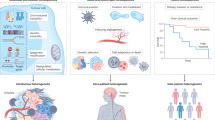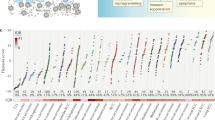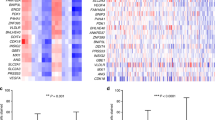Abstract
Clinical and experimental studies have suggested that tumour hypoxia is associated with poor treatment outcome and that loss of apoptotic potential may play a role in malignant progression of neoplastic cells. The tumour suppressor gene p53 induces apoptosis under certain conditions and microenvironmental tumour hypoxia may select for mutant tumour cells with diminished apoptotic potential due to lack of p53 function. The aim of this study was to evaluate the prognostic relevance of oxygenation status for treatment outcome and to compare pre-treatment tumour oxygenation measurements were done in 31 of those by PCR using DNA extracted from paraffin-embaedded sections (n = 2) or frozen biopsies (n = 29). The overall median of the tumour median pO2was 19 mmHg (range 1–58 mmHg). Only 6 tumours had functional p53 mutations and no association was found between mutant p53 and tumour hypoxia. Five out of 6 STS with lower histopathological grade were well-oxygenated whereas high-grade STS were both hypoxic and well-oxygenated. At a median follow-up of 74 months, 16 patients were still alive among 28 available for survival analysis. When stratifying into hypoxic and well-oxygenated tumours patients with the most hypoxic tumours has a statistically poorer disease-specific and overall survival at 5 years. In conclusion hypoxia was an indicator for both a poorer disease specific and overall survival in human STS but hypoxic tumours were not characterized by mutations in the p53 gene. © 2001 Cancer Research Campaign
Similar content being viewed by others
Article PDF
Change history
16 November 2011
This paper was modified 12 months after initial publication to switch to Creative Commons licence terms, as noted at publication
References
Adam MF, Gabalski EC, Bloch DA, Oehlert JW, Brown JM, Elsaid AA, Pinto HA and Terris DJ (1999) Tissue oxygen distribution in head and neck cancer patients. Head Neck 21: 146–153
Birner P, Schindl M, Obermair A, Plank C, Breitenecker G and Oberhuber G (2000) Overexpression of hypoxia-inducible Factor 1α is a marker for an unfavorable prognosis in early-stage invasive cervical cancer. Cancer Res 60: 4693–4696
Brizel DM, Scully SP, Harrelson JM and Dewhirst MW (1996) Tumor oxygenation predicts for the likelihood of distant metastasis in human soft tissue sarcoma. Cancer Res 56: 941–943
Brizel DM, Dodge RK, Clough RW and Dewhirst MW (1999) Oxygenation of head and neck cancer: changes during radiotherapy and impact on treatment outcome. Radiother Oncol 53: 113–117
Cho Y, Gorina S, Jeffrey PD and Pavletich NP (1994) Crystal structure of a p53 tumour suppressor-DNA complex: understanding tumorigenic mutations. Science 265: 346–355
Dachs GU and Tozer GM (2000) Hypoxia modulated gene expression: angiogenesis, metastasis and therapeutic exploitation. Eur J Cancer 36: 1649–1660
Di Como CJ and Prives C (1998) Human tumor-derived p53 proteins exhibit binding site selectivity and temperature sensitivity for transactivation in a yeast-based assay. Oncogene 16: 2527–2539
Durand RE (1991) Keynote address: the influence of microenvironmental factors on the activity of radiation and drugs. Int J Radiat Oncol Biol Phys 20: 253–258
Fyles AW, Milosevic M, Wong R, Kavanagh MC, Pintilie M, Sun A, Chapman W, Levin W, Manchul L, Keane TJ and Hill RP (1998) Oxygenation predicts radiation response and survival in patients with cervix cancer. [published erratum appears in Radiother Oncol 1999 Mar; 50(3):371]. Radiother Oncol 48: 149–156
Graeber TG, Osmanian C, Jacks T, Housman DE, Koch CJ, Lowe SW and Giaccia AJ (1996) Hypoxia-mediated selection of cells with diminished apoptotic potential in solid tumours. Nature 379: 88–91
Guldberg P, Nedergaard T, Nielsen HJ, Olsen AC, Ahrenkiel V and Zeuthen J (1997) Single-step DGGE-based mutation scanning of the p53 gene: application to genetic diagnosis of colorectal cancer. Hum Mutat 9: 348–355
Hockel M, Schlenger K, Aral B, Mitze M, Schaffer U and Vaupel P (1996) Association between tumor hypoxia and malignant progression in advanced cancer of the uterine cervix. Cancer Res 56: 4509–4515
Hockel M, Schlenger K, Hockel S and Vaupel P (1999) Hypoxic cervical cancers with low apoptotic index are highly aggressive. Cancer Res 59: 4525–4528
Hohenberger P, Felgner C, Haensch W and Schlag PM (1998) Tumor oxygenation correlates with molecular growth determinants in breast cancer. Breast Cancer Res Treat 48: 97–106
Jensen OM, Hogh J, Ostgaard SE, Nordentoft AM and Sneppen O (1991) Histopathological grading of soft tissue tumours. Prognostic significance in a prospective study of 278 consecutive cases. J Pathol 163: 19–24
Klijn JGM (1997). Prognostic and predictive value of p53, Elsevier Science BV: Amsterdam
Knocke TH, Weitmann HD, Feldmann HJ, Selzer E and Potter R (1999) Intratumoral pO2-measurements as predictive assay in the treatment of carcinoma of the uterine cervix. Radiother Oncol 53: 99–104
Moulder JE and Rockwell S (1984) Hypoxic fractions of solid tumours: experimental techniques, methods of analysis, and a survey of excisting data. Int J Radiat Oncol Phys 10: 695–712
Nordsmark M and Overgaard J (2000) A confirmatory prognostic study on oxygenation status and loco-regional control in advanced head and neck squamous cell carcinoma treated by radiation therapy. Radiother Oncol 57: 39–43
Nordsmark M, Bentzen SM and Overgaard J (1994) Measurement of human tumour oxygenation status by a polarographic needle electrode. An analysis of inter-and intratumour heterogeneity. Acta Oncol 33: 383–389
Nordsmark M, Overgaard M and Overgaard J (1996a) Pretreatment oxygenation predicts radiation response in advanced squamous cell carcinoma of the head and neck. Radiotherapy and Oncology 41: 31–39
Nordsmark M, Höyer M, Keller J, Nielsen OS, Jensen OM and Overgaard J (1996b) The relationship between tumour oxygenation and cell proliferation in human soft tissue sarcomas. Int J Radiat Oncol Biol Phys 35: 701–708
Nordsmark M, Keller J, Nielsen OS, Lundorf E and Overgaard J (1997) Tumour oxygenation assessed by polarographic needle electrodes and bioenergetic status measured by 31P magnetic resonance spectroscopy in human soft tissue tumours. Acta Oncol 36: 565–571
Rudat V, Vanselow B, Wollensack P, Bettscheider C, Osman-Ahmet S, Eble MJ and Dietz A (2000) Repeatability and prognostic impact of the pretreatment pO2 histography in patients with advanced head and neck cancer. Radiother Oncol 57: 31–37
Stackpole CW, Groszek L and Kalbag SS (1994) Benign-to-malignant B 16 melanoma progression induced in two stages in vitro by exposure to hypoxia. J Natl Cancer Inst 86: 361–367
Stadler P, Becker A, Feldmann HJ, Hansgen G, Dunst J, Wurschmidt F and Molls M (1999) Influence of the hypoxic subvolume on the survival of patients with head and neck cancer. Int J Radiat Oncol Biol Phys 44: 749–754
Sundfor K, Lyng H, Trope CG and Rofstad EK (2000) Treatment outcome in advanced squamous cell carcinoma of the uterine cervix: relationships to pretreatment tumor oxygenation and vascularization. Radiother Oncol 54: 101–107
Sutherland RM, Ausserer WA, Murphy BJ and Laderoute KR (1996) Tumor Hypoxia and heterogeneity: Challenges and opportunities for the future. Sem Rad Oncol 6: 59–70
Vaupel P, Schlenger K, Knoop C and Höckel M (1991) Oxygenation of human tumors: evaluation of tissue oxygen distribution in breast cancers by computerized O2 tension measurements. Cancer Res 51: 3316–3322
Vogelstein B, Lane D and Levine AJ (2000) Surfing the p53 network. Nature 408: 307–310
Vraa S, Keller J, Nielsen OS, Sneppen O, Jurik AG and Jensen OM (1998) Prognostic factors in soft tissue sarcomas: the Aarhus experience. Eur J Cancer 34: 1876–1882
Author information
Authors and Affiliations
Rights and permissions
From twelve months after its original publication, this work is licensed under the Creative Commons Attribution-NonCommercial-Share Alike 3.0 Unported License. To view a copy of this license, visit http://creativecommons.org/licenses/by-nc-sa/3.0/
About this article
Cite this article
Nordsmark, M., Alsner, J., Keller, J. et al. Hypoxia in human soft tissue sarcomas: Adverse impact on survival and no association with p53 mutations. Br J Cancer 84, 1070–1075 (2001). https://doi.org/10.1054/bjoc.2001.1728
Received:
Revised:
Accepted:
Published:
Issue date:
DOI: https://doi.org/10.1054/bjoc.2001.1728
Keywords
This article is cited by
-
Oxygen Imaging of a Rabbit Tumor Using a Human-Sized Pulse Electron Paramagnetic Resonance Imager
Molecular Imaging and Biology (2024)
-
Transiently hypoxic tumour cell turnover and radiation sensitivity in human tumour xenografts
British Journal of Cancer (2022)
-
Interfering with Tumor Hypoxia for Radiotherapy Optimization
Journal of Experimental & Clinical Cancer Research (2021)
-
Predictive and prognostic transcriptomic biomarkers in soft tissue sarcomas
npj Precision Oncology (2021)
-
Tissue pO2 distributions in xenograft tumors dynamically imaged by Cherenkov-excited phosphorescence during fractionated radiation therapy
Nature Communications (2020)



